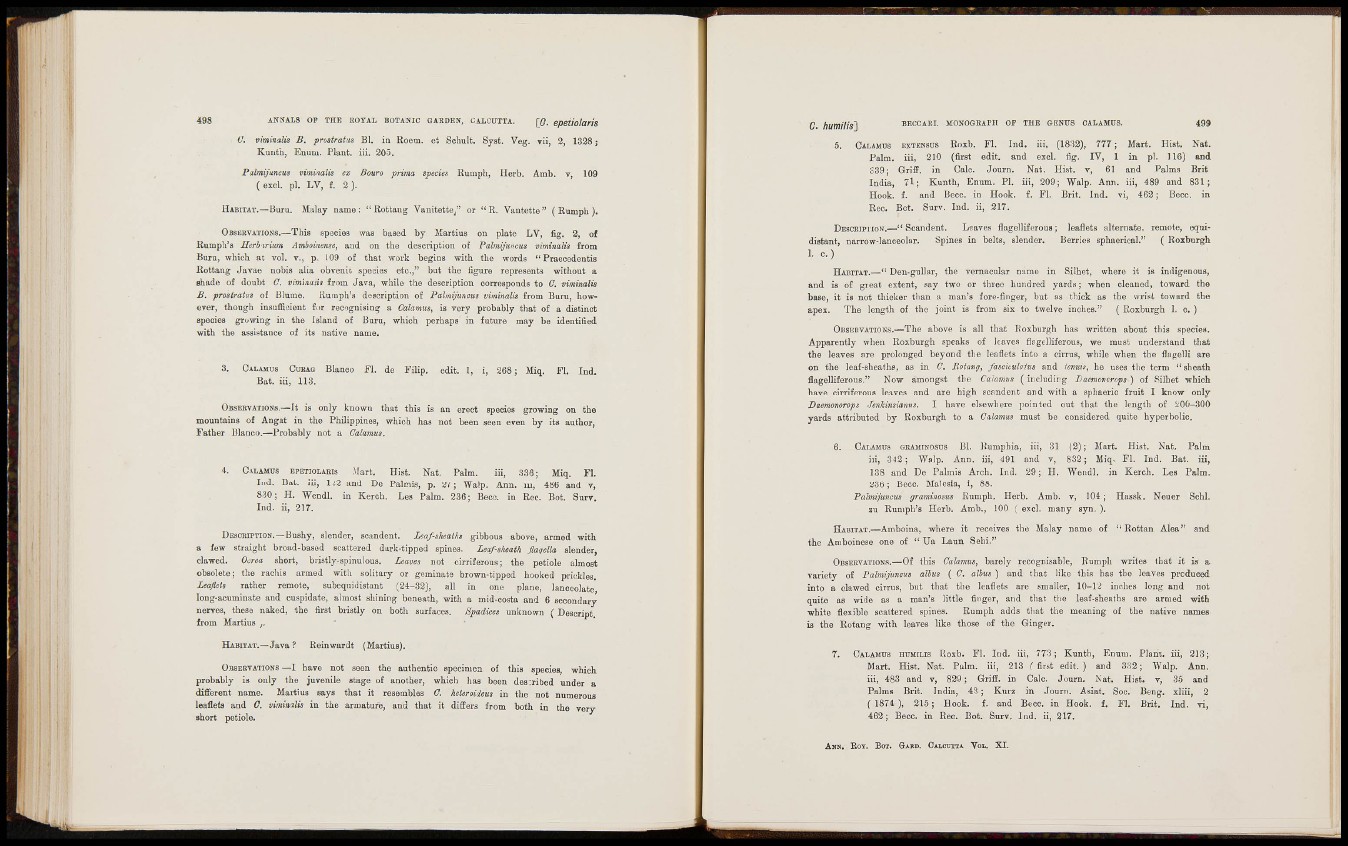
4 9 8 ANNALS OP THE ROYAL BOTAUIC GARDEN, CALCUTTA. [(}. EPETIOLAHS
0. viminalis B. prustratus Bl. in Roem. ei Schult. Syst, Veg. vii, 2, 1328;
Kuiith, Enuni. Plant, iii. 205,
Palmijuncus viminalis ex Bouro prima species Rumph, Herb. Amb. v, 109
( excl. pi. LV, f. 2 ).
HABiiAr.—Buru. Malay name; "Rottaug Vanitette;' or "R, Vaatofcte" ( Rumpb ).
OsseRVATiONS.—Tbia species was baaed by Martius on plate LV, fig. 2, of
Rumph's Serb'inim Amboinense, and on the description of Falmijuncus vimiiialis from
Buru, which at vol. v., p. 109 of that "vTork begins with the words " Praecedeutis
Rottang Javae nobis alia obvenit species etc.," but the figure represents without a
shade of doubt C. vimhiaiii from Ja^a, while the description corresponds to 0. viminalis
B. prostratiis of Blume. Rumph'a description of Palmijuncus vimnalis from Buru, however,
though insufficient for recngnising a Calamus, is very probably that of a distinct
species growing in the Island of Buru, which perhaps in future may be identitied
with the assistance of its native name.
3. CALAMUS CUKAG Blanco Fl. de Filip. edit. 1, i, 268; Miq. Fl. Ind.
Bat. iii, 113.
OBSERVATIONS.—it is only known that this is an erect species growing on the
mountains of Angat in the Philippines, which has not been seen even by its author,
Father Blanco.—Probably not a Calamus.
4. CALAUDS EPETIOLARIS Mart. Hist. Nat. Palm. iii, 336; Miq. Fl.
Ind. Bat. iii, 1^2 and De Palmis, p. 27; Walp. Ann. iii, 486 and v,
8 3 0 ; H. Wendl. in Kerch. Les Palm. 236; Becc. in Ree. Bot. Surv.
Ind. ii, 217.
DEsCRiPnoN.—Bushy, slender, scandent. L',af-sheatha gibbous above, armed with
a few straight broad-based scattered dark-tipped spines. Leof-sheaih Jlaqella slender,
clawed. Ocrea short, bristly-spinulous. Leaves not cirriferous; the petiole almost
obsolete; the rachis armed with solitary or geminate brown-tipped hooked prickles.
LeajleU rather remote, subequi distant (24-32), all in one plane, lanceolate
long-acuminate and cuspidate, almost shining beneath, with a mid-costa and 6 secondary
nerves, these naked, the first bristly on both surfaces. Spadicea unknown ( Descript
from Martius
HABITAT.—Java ? Reinwardt (Martius).
OBSERVATIONS — I have not seen the authentic specimen of this species, which
probably is only the juvenile stage of another, which has been des;ribed under a
different name. Martius says that it resembles C. heteroideus in the not numerous
leaflets and C. viminalis in the armature, and that it differs from both in the very
short petiole.
C. humiUs] BECCAKI. MONOGKAPII OP THE GENUS CALAMUS. 4 9 9
CALAMUS EXTBNSUS Roxb. FL Ind. iii, (1832), 777; Mart. Hist. Nat.
Palm, iii, 210 (first edit, and excl. fig. IV, 1 in pi. 116) and
539; Griff, in Cale. Journ. Nat, Hist, v, 61 and Palms Brit
India, 7 l ; Kunth, Enum. PI. iii, 209; Walp, Ann, iii, 489 and 831;
Hook. f. and Beco, in Hook. f. Fl. Brit. Ind. vi, 462; Becc, in
Ree. Bet. Surv. Ind. ii, 217.
DESCRIPJIOH.—"Scandent. Leaves flagelliferous; leaflets alternate, remote, equidiatant,
narrow-lanceolar. Spines in belts, slender. Berries sphaerical." ( Roxburgh
1. c .)
HABITAT.—" Den-gullar, the vernacular name in Silhet, where it is indigenous,
and is of great extent, say two or three hundred yards ; when cleaned, toward the
base, it is not thicker tlian a man's fore-finger, but as thick as the wrisl, toward the
apex. The length of the joint is from six to twelve inclies." ( Roxburgh I, c. )
OBSERVATIONS.—The above is all that ¡Roxburgh has written about this species.
Apparently when Roxburgh speaks of kaves flagelliferous, we must understand that
the leaves are prolonged beyond the leaflets into a cirrus, while when the ilaijelli are
on the leaf-sheaths, as in C. Roiavg, fasciculaius and lenuif, he uses tlie term "sheath
flagelliferous." Now amongst the Caiamns ( i n c l u d i r g Baemcticrops ) of Silhet which
have cirriferous leaves and are high scandent and with a sphaeric fruit I know only
Daemonorops Jenkinsianus. I have elsewhere pointed out thai the length of ii00-300
yards attributed by Roxburgh to a Calamus must bo considered quite hyperbolic.
6. CALAMDS GRAMINOSUS Bl. Kumphia, iii, 31 (2); Mart. Hist. Nat, Palm
ili, 3 4 2 ; Wfllp. Ann. iii, 491 and v, 832; Wiq- Fl. Ind. Bat. iii,
138 and De Palmis Arch. Ind. 29; H. Wendl. in Kerch. Lea Palm.
236 ; Beco. Malesia, i, 88.
Palmijuncus graminosus Rumph. Herb. Amb. v, 104 ; Hassk, Neuer Schl.
zu Runiph's Herb. Amb., iOO ( excl. many syn. ).
HABITAT.—Amboina, where it receives the Malay name of " Rottan Alea" and
the Amboinese one of " U a Laun Sehi."
OBSERVATIONS.—Of this Calamus, barely recognisable, Rumph writes that it is a
variety of Palmijuncus albus ( C. alhus ) and that like this has the leaves produced
i n t o a clawed cirrus, but that the leaflets are smaller, 10-12 ini^hes long and not
quite as wide as a man's little finger, and that tlie leaf-sheaihs are armed with
white flexible scattered spines. Rumph adds that the meaning of the native names
i s the Rotang with leaves like those of the Ginger.
7. CALAMUS HÜMILIS Roxb. Fl. Ind. üi, 773; Kunth, Enum. Plant, iii, 213;
Mart. Hist. Nat. Palm, iii, 213 ( first edit. ) and 332; Walp. Ann.
iii, 483 and v, 829; Griff, in Calc, Journ. Nat. Hist. v, 35 and
Palma Brit. India, 43 ; Kurz in Journ. Asiat. Soc. Beng. xliii, 2
( 1874 ), 215; Hook. f. and Becc. in Hook. f. Fl. Brit. Ind. vi,
4 6 2 ; Becc. in Ree. Bot. Surv. l a d . ii, 217.
ANN. ROT. BOT. GABD. CAICÜIIA VOL. X I.